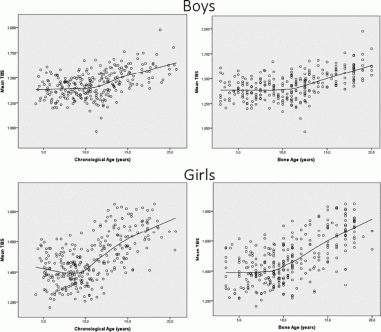ICCBH2017 Poster Presentations (1) (209 abstracts)
The role of bone age in the evaluation of trabecular bone score (TBS) of children and adolescents 5--19 years old
Miguel Angel Guagnelli 1 , Regina Ambrosi 1 , Desiree Lopez-Gonzalez 1 , Renaud Winzenrieth 2 , Luis Del Rio 3 & Patricia Clark 1
1Clinical Epidemiology Unit, Hospital Infantil de Mexico Federico Gomez, Mexico City, Mexico; 2R&D Department, Med-Imaps, Pessac, France; 3CETIR Medical Centre, Barcelona, Spain.
Rationale: Trabecular Bone Score (TBS) is a texture-based tool analyzing DXA images in order to assess bone microarchitecture in the lumbar region. In pediatric population, definition of normative values has remained elusive due to the disparities of results in normal population, probably link to uncontrolled factors which impact bone microarchitecture and the nonlinear behavior of bone growth. Our objective was to evaluate TBS in healthy Mexican children and adolescents using chronological age or bone age (BA) taking into account skeletal maturation and puberty onset as confounding variables.
Method: DXA acquisitions from 269 boys and 296 girls aged 5–20 years were included. Bone age was evaluated according to Greulich and Pyle method. Pseudo volumetric BMD (3D BMD) was calculated based on cylindrical model proposed by Kroeger et al. (Bone Mineral, 1992). TBS assessment was evaluated using a custom version of TBS (Med-Imaps SASU, France) that includes a soft tissue correction for pediatric subjects. The LMS statistical method proposed by Cole and Green (Stat Med, 1992) was used to construct aBMD, vBMD and TBS age-related curves using LMSchartmaker 2.0.
Results: When chronological age was used, girls’ curve showed decreasing phase delineating a ‘U’ shape1. However, when evaluated with bone age, both graphs show constant TBS until 9 years in girls and 12 years in boys with accordance to the age of puberty, the onset of which is different between genres, a well-known phenomenon.
Discussion: Bone age, better related to puberty onset than chronological age, may be more useful to interpret TBS. This preliminary data need to be reproduced by other groups in healthy children and adolescents as well as in groups with different pathologies affecting this population.

Disclosure: The authors declared no competing interests




